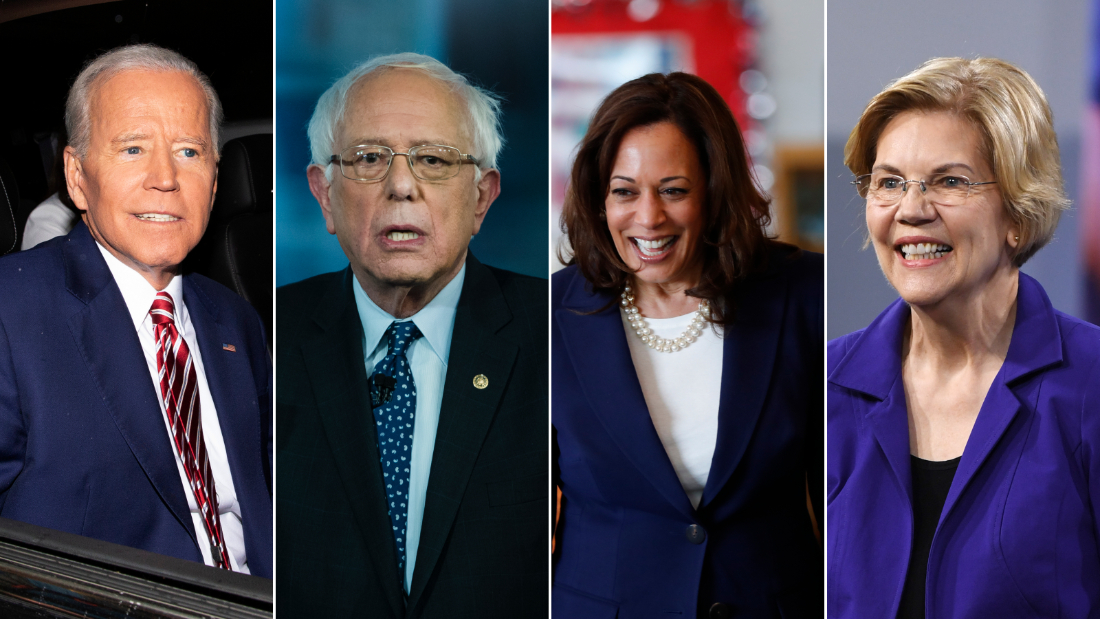
Poll of the week: A new national Monmouth University poll of potential Democratic primary voters finds former vice president Joe Biden leading with 33%, Bernie Sanders at 15%, Kamala Harris at 11%, Elizabeth Warren at 10%, Pete Buttigieg at 6% and Beto O'Rourke at 4%.
That closely matches the average of live interview polls over the last 10 days that puts Biden at 34%, Sanders at 16%, Warren at 11%, Harris at 8%, Buttigieg at 6% and O'Rourke at 3%.
What's the point: There will be a lot of focus at identifying microtrends in voter preferences this primary season. You can already hear it: "So-and-so candidate is up over the last few weeks, and so-and-so candidate is down."
But with the first contests still more than eight months away, the big question is whether there is movement over the long-term.
And so far, when it comes to the long-term, the Democratic race has barely moved.
Take a look at a CNN poll taken back in October. Biden led the field at 33%, followed by Sanders at 14%, Harris at 10% and Warren at 9%. O'Rourke came in at 4%. Buttigieg, who wasn't on the national radar at that point, was not asked about.
Compared to this week's Monmouth poll, the top four candidates are all the same. None of the top four candidates' vote shares differ by more than a point. O'Rourke's is exactly the same. Only Buttigieg, who likely would have polled at 0% in October had he been asked about, has seen notable movement.
Now, this isn't to say that things won't move in the future. There have certainly been movements in the short-term, such as bumps after candidates have officially announced their campaigns. But those tend to dissipate over time; that has certainly been the case this election cycle.
In some ways, it shouldn't be surprising that things haven't shifted too much. It's only Memorial Day weekend 2019. While most in the media (and probably most of you reading this article) are paying close attention to the campaign, a majority of Democrats (56%) told Quinnipiac University this past week that they were only paying some to no attention to the campaign.
Still, even though a majority of Democrats aren't paying very close attention, more Democrats than normal are compared to prior years. According to that Quinnipiac poll, 44% of Democrats are paying a lot of attention to the campaign. Just 25% of Democrats said they were paying a lot of attention at this point in the 2016 campaign in a CBS News poll. At this point in 2008, 21% of Democrats were saying that they were paying a lot of attention. And back at this point in 2004 and 2000 respectively, it was only 13% and 8%.
The fact that more voters than usual have tuned in early and little movement has occurred suggests that perhaps there is a lower chance the polls will change than usual.
Indeed, look closely at the Quinnipiac poll; voters paying closest attention to the race suggests a similar possibility of little movement. While Biden did somewhat better with voters paying a lot of attention compared to how he did with the overall electorate and Sanders did somewhat worse, the difference in primary preference between Democrats paying closest attention and the overall electorate is shockingly small. Biden is well ahead among both.
Obviously, we'll have to wait and see if the debates and other campaign events over the next few months change the course of the campaign. The past isn't necessarily predictive of the future. So far, however, the day-to-day developments of the campaign mostly haven't moved the needle -- or, at the very least, these needle movements have mostly cancelled themselves out.
Bagikan Berita Ini















0 Response to "Who's up and who's down in the 2020 Democratic primary? Basically no one."
Post a Comment